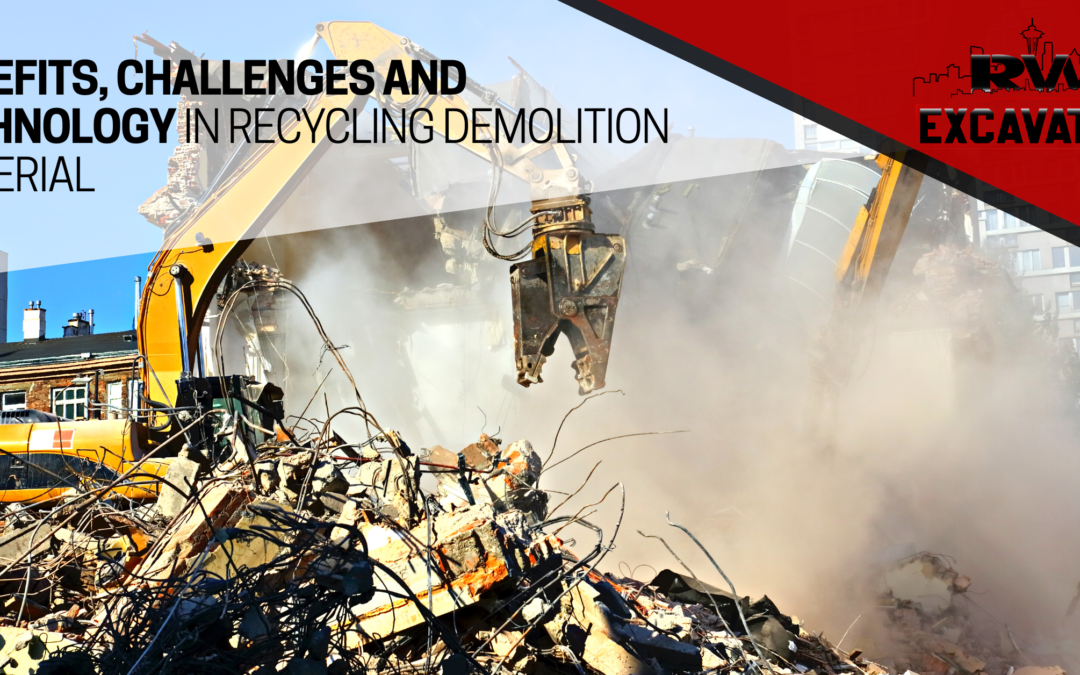Demolition is a necessary part of the construction industry, but it generates a significant amount of waste.
Recycling materials from demolition sites is critical to reducing waste, conserving natural resources, and minimizing the environmental impact of demolition activities.
In this blog, we will explore the benefits of recycling materials in the demolition industry, the challenges of implementing recycling programs, and some of the latest technologies and innovations that are making recycling more accessible and cost-effective.
Benefits of Recycling Materials in the Demolition Industry
Reducing Waste in Landfills
Recycling materials from demolition sites helps to reduce the amount of waste that ends up in landfills.
Landfills are not only unsightly, but they also generate harmful greenhouse gases that contribute to global warming.
By recycling materials, we can reduce the amount of waste that ends up in landfills and reduce our carbon footprint.
According to the US Environmental Protection Agency, recycling construction and demolition materials can save 3.3 million metric tons of carbon dioxide equivalent emissions annually.
Conserving Natural Resources
Many of the materials used in construction, such as metal, wood, and concrete, are non-renewable resources. By recycling these materials, we can reduce our reliance on virgin materials and extend the life of existing resources.
Recycling also reduces the demand for new raw materials, which reduces energy consumption and greenhouse gas emissions. For example, recycling one ton of steel saves 2,500 pounds of iron ore, 1,400 pounds of coal, and 120 pounds of limestone.
Cost-Effective
Recycling materials can help reduce disposal costs for contractors and developers, as recycling is often less expensive than landfilling.
In addition, recycling materials can also generate revenue through the sale of recovered materials such as metal, which can be sold to scrap yards.
According to the Construction & Demolition Recycling Association, recycling construction and demolition materials can save between $3 and $5 per ton.
Challenges of Implementing Recycling Programs in the Demolition Industry
Sorting and Processing
One of the key challenges to recycling materials in the demolition industry is sorting and processing the materials.
Demolition generates a wide variety of materials, and separating and processing them can be time-consuming and labor-intensive.
For example, concrete and asphalt are often crushed and used as aggregate in new construction, while wood can be chipped and used as mulch or fuel. Metals such as steel, copper, and aluminum can be sold to scrap yards, while gypsum drywall can be used as a soil amendment or to manufacture new drywall.
However, the process of sorting and processing these materials can be complex and require specialized equipment and facilities. This can be a significant barrier for small contractors and developers who may not have the resources to invest in recycling infrastructure.
To address this issue, some recycling companies have developed mobile recycling equipment that can be brought directly to the demolition site, reducing the transportation costs and time required for processing the materials.
Lack of Awareness and Education
Another obstacle to the widespread adoption of recycling in the demolition industry is a lack of awareness and education. Many contractors and developers are not aware of the benefits of recycling, and they may not have access to information on how to recycle materials.
In addition, recycling regulations can vary by state and municipality, making it challenging for contractors and developers to navigate the requirements.
To address this issue, it is important to raise awareness and provide education and resources to help contractors and developers recycle materials more effectively.
For example, some municipalities have developed recycling guides and resources specifically for the construction and demolition industry, providing information on what materials can be recycled and how to properly dispose of hazardous materials.
Latest Technologies and Innovations in Demolition Recycling
Mobile Recycling Equipment
As mentioned earlier, one of the challenges to recycling materials in the demolition industry is the sorting and processing of the materials.
Mobile recycling equipment has emerged as a potential solution to this problem. Mobile equipment can be brought directly to the demolition site, reducing transportation costs and the time required for processing the materials.
One example of mobile recycling equipment is a portable crushing and screening plant. This equipment can crush concrete and other materials on site, reducing the amount of material that needs to be transported to a processing facility.
Portable equipment can also be used to screen and separate materials, reducing the amount of contamination and ensuring that materials are processed more efficiently.
Robotics and Automation
Advances in robotics and automation are also changing the way that demolition materials are processed and recycled. Robotic equipment can be used to sort and separate materials more efficiently, reducing the amount of manual labor required.
For example, robotic arms can be used to sort and separate metals from other materials, while automated conveyor belts can be used to transport materials from one location to another.
In addition to improving efficiency, robotics and automation can also improve safety on demolition sites. By reducing the amount of manual labor required, robotic equipment can help reduce the risk of injury to workers.
This technology can also be used to identify hazardous materials and remove them from the demolition site, further reducing the risk of exposure to workers and the environment.
Waste-to-Energy
Another innovation in the demolition recycling industry is the use of waste-to-energy technology.
This technology involves converting waste materials into energy through processes such as incineration or gasification. By converting waste into energy, this technology can help reduce the amount of waste that ends up in landfills and reduce the demand for fossil fuels.
One example of waste-to-energy technology is the use of gasification to convert wood waste into energy. Gasification involves heating wood waste in the absence of oxygen, producing a gas that can be used to generate electricity or heat.
This technology can be particularly useful for demolition sites that generate large amounts of wood waste, such as those involved in the removal of old buildings.
Conclusion
Recycling materials in the demolition industry is essential for reducing waste, conserving natural resources, and minimizing the environmental impact of demolition activities. Recycling also offers cost benefits for contractors and developers, and advances in technology are making it easier to sort and process materials.
However, to achieve widespread adoption of recycling, more education and awareness are needed to ensure that contractors and developers understand the benefits of recycling and have the resources to do so effectively. Mobile recycling equipment, robotics and automation, and waste-to-energy technology are just a few examples of the latest innovations that are making recycling more accessible and cost-effective.
Ultimately, by working together to overcome the challenges of recycling materials in the demolition industry, we can reduce waste, conserve natural resources, and create a more sustainable future for ourselves and for generations to come.
Would you like to work with a demolition contractor that utilizes these demolition practices?
Give us a call or read more about our demolition services here.

